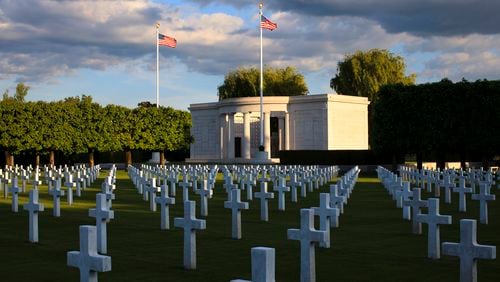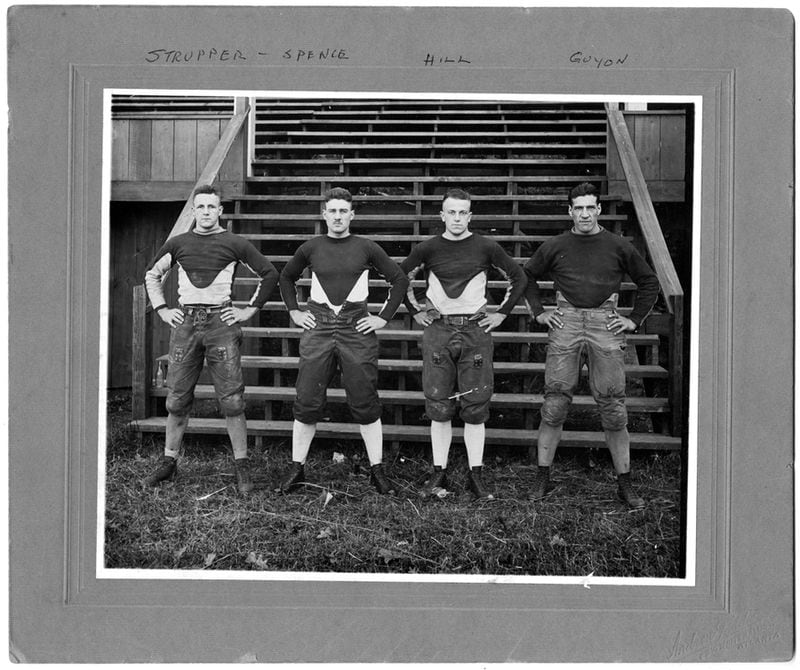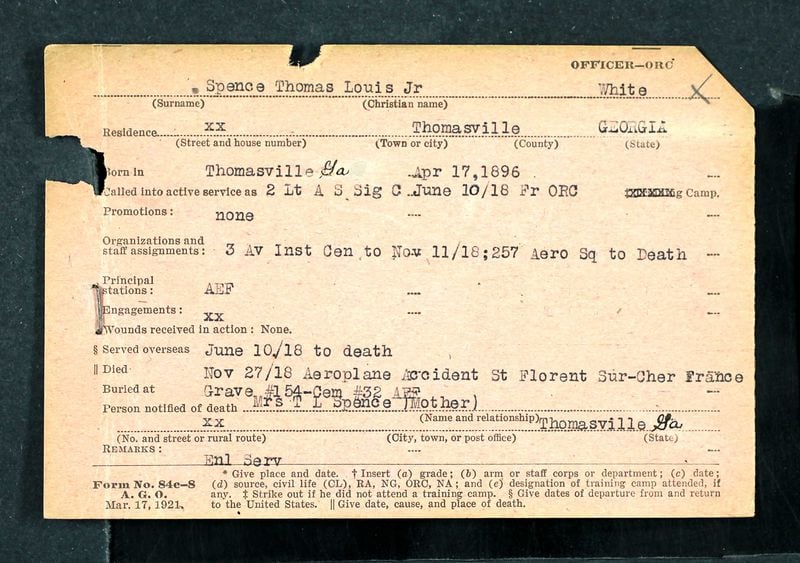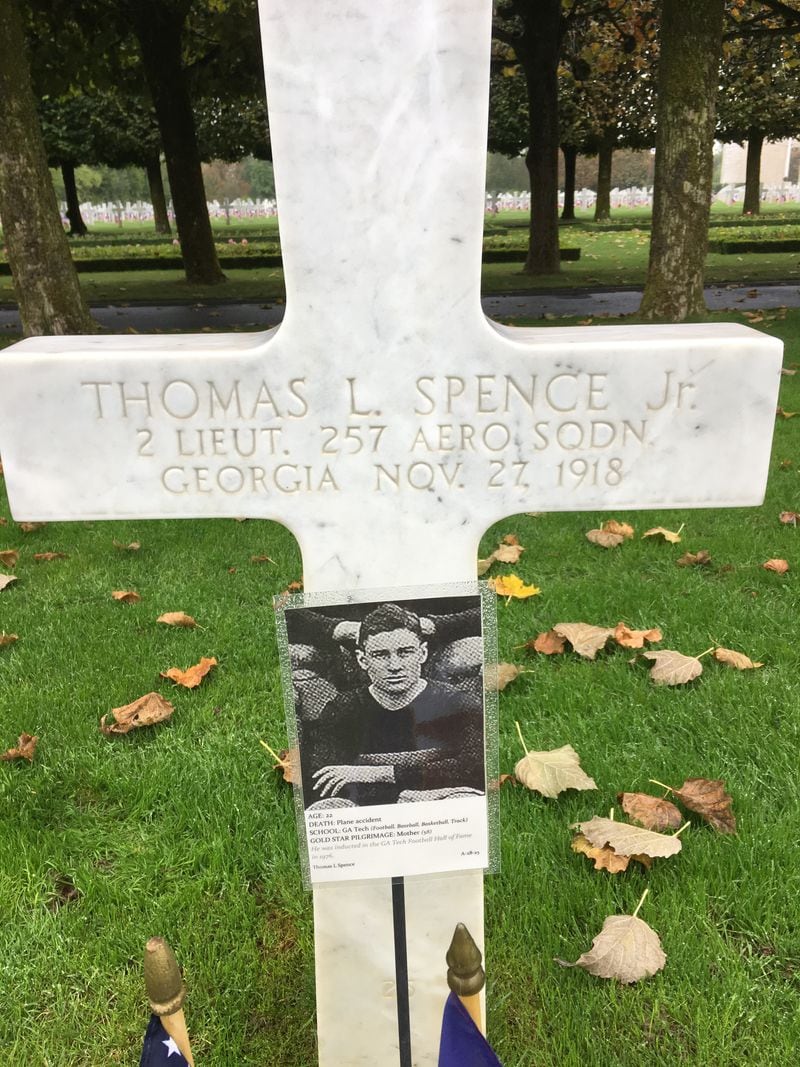On Sunday, on a pristinely landscaped 40.5-acre plot of land in the east of France, the memories of 4,135 men and women who paid the ultimate sacrifice in the service of their country were to be honored. The day marks the centennial anniversary of the armistice that ended World War I, and at St. Mihiel American Cemetery in Thiaucourt, France, a ceremony was to begin at 11 a.m. local time.
Among those who rests there beneath a white marble headstone in the shape of a Christian cross is a Georgia Tech legend.
Tommy Spence was a fullback in the John Heisman era. From Thomasville, Spence scored five touchdowns in the famous 222-0 win over Cumberland in 1916. He was selected to the All-Southern team the same year. He also played basketball, baseball and ran track. He was posthumously inducted into Tech’s sports hall of fame in 1976.
Spence’s willingness to leave school and the glories of college football to risk his life in service of his country speaks to different way of life from a different time, and valor and patriotism worth honoring.
Thomas Louis Spence Jr. lettered for the Jackets (then known as the Golden Tornado) 1914-16. An Atlanta Constitution story reporting his death in November 1918 called him “one of the greatest football players who ever wore old gold and white of Georgia Tech.” The 1915 and 1916 teams were a combined 15-0-2, and the latter won Tech’s first championship of the Southern Intercollegiate Athletic Association, a forerunner of the SEC.
He was one of five Tech players named to the All-Southern team in 1916, part of a team that set the stage for the Golden Tornado in 1917 to become the first team from the South to be recognized as a national champion.
But, by that point, Spence was no longer in school. He enlisted in August 1917 at the age of 21, four months after the U.S. joined the Allied war effort. He was called into active duty in June 1918 as a second lieutenant in the 257th Aero Squadron. Reports following his death indicate that he was a pilot.
Spence’s death actually followed the end of World War I, on November 27, 1918, 16 days after the armistice. A military card documenting his service cited his death resulting from an “aeroplane accident” in St. Florent Sur-Cher in central France. An Atlanta Constitution story from December 25, 1918, citing a letter received by Spence’s parents from a friend and Tech classmate also in the service, said that Spence was flying to Bordeaux in the southwest of France to spend the day with friends from Thomasville stationed there.
First, Spence flew from an air training station in Issoudun (in central France) to a camp west of the base to inform a friend who had invited him to share Thanksgiving with him (the same man who wrote to Spence’s parents, a Captain Patten) of his plans.
“As Captain Patten finished reading the note he looked up and saw that Lieutenant Spence was having trouble with his plane, over which he seemed to have lost control, and it was fast coming down,” the story reported. “He jumped at once into a car and was at the place where the plane fell in a few minutes, but he found young Spence with life already extinct and the airplane a mass of wreckage.”
The letter from Patten apparently theorized mechanical failure. With aviation in its infancy and the demand for pilots high, airplane crashes and fatalities in World War I were dangerously common, requiring uncommon fearlessness among pilots like Spence. According to the Royal Air Force Museum website, the life expectancy for new pilots in the British air force in 1917 could be measured in weeks.
Spence was 22 at the time of his death, never again to play football or grow into adulthood. The Constitution reported that he had planned to return to Tech to finish his degree and play one more season. (Naturally, it also cited his standout play in Tech’s 1916 win over Georgia, his last athletic feat of note.)
“Tech not only lost a good football player, but a good student, and Atlantans who knew Tommy Spence learned to like him not only as a football player, but as a man. He was one of the most popular students who ever attended the local school,” the story wrote.
Spence was one of roughly 117,000 Americans to lose their lives in World War I.
It is unclear when Spence’s body was moved to St. Mihiel, which is about 225 miles northeast of Issoudun. It was the site of a major American offensive against the German army and was established as a permanent burial site after the war. (The American Battlefield Monuments Commission maintains 26 permanent burial grounds like St. Mihiel on foreign soil.)
Families of the dead could choose to have remains brought back to the U.S. or interred in American cemeteries such as St. Mihiel. About 35 percent of the bodies remained.
Spence is not the only person buried at St. Mihiel who attended Georgia Tech. There is at least one other, Robert Wallace Jr., a lieutenant from Atlanta who was killed in action August 29, 1918.
The cemetery receives a steady flow of visitors, including many French citizens and schoolchildren.
“The French have not forgotten what America did for them,” Saint Mihiel superintendent Jeffrey Hays wrote in an e-mail to the AJC. “Twice. They helped us in our Revolution.”
Hays, incidentally, is a retired Fulton County firefighter. He and his wife Jackie have extensively researched the lives of the 4,153 buried at St. Mihiel, finding draft registration cards, census reports, college yearbooks and passenger lists recording the trans-Atlantic voyages that brought the young men and women from America, never to return. Photos of the dead are placed next to the graves during the summer months.
Spence was memorialized with the naming of an Air Force base in his honor that was in operation from 1941 to 1961. It is located near Moultrie, about 25 miles north of Spence’s native Thomasville in south Georgia. It is now a city-owned airport, still named for him.
Perhaps the more meaningful dedication remains in a cemetery at the west edge of Thiaucourt, about 150 miles to the east of Paris. Inscribed at the base of a sundial at the center of the cemetery are the words of General John Pershing, who commanded American forces in World War I and was instrumental in the establishment of burial grounds and memorials such as St. Mihiel where American soldiers are interred on foreign soil:
“Time will not dim the glory of their deeds.”










